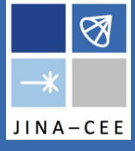Speaker
Ilka Petermann
(Arizona State University)
Description
Following the convective core burning of hydrogen and helium in
massive stars the next phase, core carbon burning, can proceed either
convectively or radiatively. Under certain thermodynamic conditions core carbon-burning
generates enough energy for the energy released to be transported by
convection. Otherwise, the nuclear energy generated is too small
relative to thermal neutrino losses to drive convection and the core
burns carbon radiatively. The change between the two burning types is a key transition
in massive star evolution that is assumed to affect all subsequent stages and result in a bimodal distribution of the remnants of massive stars.
In this work, we analyze the transition between convective and radiative core carbon
burning in MESA massive star models between 15 and 21 M$_{\odot}$ as a function of ZAMS mass, initial metallicity, rotation, mass-loss, and the $^{12}$C($\alpha$,$\gamma$)$^{16}$O rate.
Primary author
Ilka Petermann
(Arizona State University)
Co-authors
Mr
Carl Fields
(Michigan State University)
Dr
Robert Farmer
(University of Amsterdam)
Dr
William Wolf
(Arizona State University)
fx timmes
(asu)
